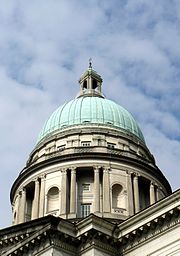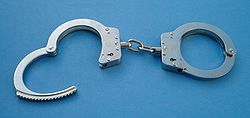- Criminal law of Singapore
-
 A variety of activities ranging from smoking to carrying durians is banned on Singapore's Mass Rapid Transit system.
A variety of activities ranging from smoking to carrying durians is banned on Singapore's Mass Rapid Transit system.
Although the legal system of Singapore is a common law system, the criminal law of Singapore is largely statutory in nature. The general principles of criminal law, as well as the elements and penalties of common criminal offences such as homicide, theft and cheating, are set out in the Penal Code.[1] Other important offences are created by statutes such as the Arms Offences Act,[2] Kidnapping Act,[3] Misuse of Drugs Act[4] and Vandalism Act.[5]
In addition, there is a perception that Singapore society is highly regulated through the criminalization of many activities which are considered as fairly harmless in other countries. These include failing to flush toilets after use,[6] littering,[7] jaywalking,[8] the possession of pornography,[9] the sale of chewing gum,[10] and sexual activity; such as oral and anal sex between men.[11] It has been claimed that one of the results of such heavy regulation is that Singapore has one of the lowest incidences of violent crimes in the world.[12] A catchphrase recently used in a police anti-crime campaign was "Low crime does not mean no crime".
Singapore retains both corporal punishment (in the form of caning) and capital punishment (by hanging) as punishments for serious offences. For certain offences, the imposition of these penalties is mandatory. More than 400 people were executed in Singapore, mostly for drug trafficking, between 1991 and 2004. Statistically, Singapore has one of the highest execution rates in the world relative to its population, surpassing Saudi Arabia.[13] Science fiction writer William Gibson famously described Singapore as "Disneyland with the death penalty".[14]
Contents
History
Criminal law: The Penal Code
For most of the 19th century the criminal law which applied in the Straits Settlements (comprising Prince of Wales' Island (Penang), Singapore and Malacca) was that of the United Kingdom, insofar as local circumstances permitted. There was little doubt that at the time English common law crimes were recognized in these territories. However, due to problems such as doubts as to the applicability of Indian Acts, in 1871 the Straits Settlements Penal Code 1871[15] was enacted. It came into operation on 16 September 1872. The Code was practically a re-enactment of the Indian Penal Code.
Over the years, the Penal Code has been amended several times. In 1973 punishments for certain offences were enhanced, and by the Penal Code (Amendment) Act 1984,[citation needed] which came into effect on 31 August 1984, mandatory minimum penalties were introduced for certain offences. A major review of the Code was launched in 2006.
Criminal procedure
Prior to 1870 the law relating to criminal procedure in force in Singapore was found mainly in the Indian Criminal Procedure Act 1852,[16] which was applicable because the Supreme Government of India had power to legislate for the Straits Settlements. After the passing of the Penal Code in 1871, the Indian Act was replaced by the Criminal Procedure Ordinance.[17] However, in general it continued to apply the English system of criminal procedure to the Penal Code. This was subsequently found to be impracticable as the Penal Code had done away with the division of crimes into felonies and misdemeanours. Accordingly, the Criminal Procedure Ordinance 1873[18] was passed to remedy the situation. The Ordinance also did away with the procedure for indictments in favour of charges for all criminal offences; and abolished the grand jury, and special and common juries.
A new Code of Criminal Procedure was enacted in 1902.[citation needed] The present Criminal Procedure Code[19] was passed by the Legislative Council of the Colony of Singapore on 28 January 1955. All criminal offences under the Penal Code or other statutes are inquired into and tried according to the Criminal Procedure Code.
The Penal Code
Main article: Penal Code (Singapore)The Penal Code, which is the main statute in Singapore relating to criminal law, has over 500 sections and is divided into the following 24 chapters:
- Chapter I: Preliminary.
- Chapter II: General Explanations.
- Chapter III: Punishments.
- Chapter IV: General Exceptions.
- Chapter V: Abetment.
- Chapter VA: Criminal Conspiracy.
- Chapter VI: Offences Against the State.
- Chapter VIA: Piracy.
- Chapter VII: Offences Relating to the Armed Forces.
- Chapter VIII: Offences Against the Public Tranquillity.
- Chapter IX: Offences By or Relating to Public Servants.
- Chapter X: Contempts of the Authority of Public Servants.
- Chapter XI: False Evidence and Offences Against Public Justice.
- Chapter XII: Offences Relating to Coin and Government Stamps.
- Chapter XIII: Offences Relating to Weights and Measures.
- Chapter XIV: Offences Affecting the Public Health, Safety, Convenience, Decency and Morals.
- Chapter XV: Offences Relating to Religion.
- Chapter XVI: Offences Affecting the Human Body.
- Offences Affecting Life.
- Causing Miscarriage; Injuries to Unborn Children; Exposure of Infants; and Concealment of Births.
- Hurt.
- Wrongful Restraint and Wrongful Confinement.
- Criminal Force and Assault.
- Kidnapping, Abduction, Slavery and Forced Labour.
- Rape.
- Outrages on Decency.
- Chapter XVII: Offences Affecting Property.
- Theft.
- Extortion.
- Robbery and Gang-Robbery.
- Criminal Misappropriation of Property.
- Criminal Breach of Trust.
- Receiving Stolen Property.
- Cheating.
- Fraudulent Deeds and Dispositions of Property.
- Mischief.
- Criminal Trespass.
- Chapter XVIII: Offences Relating to Documents and to Currency Notes and Bank Notes.
- Currency Notes and Bank Notes.
- [There is no Chapter XIX.]
- Chapter XX: Offences Relating to Marriage.
- Chapter XXI: Defamation.
- Chapter XXII: Criminal Intimidation, Insult and Annoyance.
- Chapter XXIII: Attempts to Commit Offences.
The Penal Code defines the elements of each offence and prescribes the maximum, and occasionally also the minimum, penalties for it. The basic form of an offence (commonly referred to as the "simple offence" or, using Latin terminology, as the "offence simpliciter") has the lowest penalties. More serious forms of the offence are defined as separate offences and attract stiffer penalties.
For instance, theft is defined in section 378 of the Code, and section 379 makes simple theft (or theft simpliciter) an offence punishable with imprisonment of up to three years or with fine or both. Section 379A punishes the theft of a motor vehicle or any component part of a motor vehicle with imprisonment of not less than one year and not more than seven years and a fine. Sections 380 and 381 respectively make it offences to commit theft in any building, tent or vessel which is used as a human dwelling or for the custody of property; and, while being a clerk or servant, or being employed in the capacity of a clerk or servant, to commit theft of any property in the possession of one's master or employer. In both cases the penalty is imprisonment of up to seven years and a fine. The most serious theft offence is that of committing theft, having made preparation for causing death or hurt or restraint, or fear of death or of hurt or of restraint, to any person in order to commit the theft, or in order to effect an escape after committing the theft, or in order to retain property taken by the theft. The maximum penalty is imprisonment for up to ten years and caning with not less than three strokes.
An offender is usually charged with the most serious offences that can be established on the facts of the case. On representations being made by the offender's lawyer to the prosecuting authority, the Prosecution may agree to charge the offender with lesser offences provided that he or she agrees to plead guilty to the reduced charges.
Other significant offences
Drug trafficking
Narcotics laws established by the Misuse of Drugs Act are very strict. Anyone caught with more than 15 grams (0.53 oz) of heroin (diamorphine), 30 grams (1.1 oz) of cocaine or morphine, 250 grams (8.8 oz) of methamphetamine, or 500 grams (18 oz) of cannabis faces mandatory capital punishment, as they are deemed to be trafficking in these substances.[20] The stated quantities are the net weight of the substances after they have been isolated by laboratory analysis. Between 1991 and 2004, 400 people were hanged in Singapore, mostly for drug trafficking, one of the highest per-capita execution rates in the world.[13]
See also
- Caning in Singapore
- Capital punishment in Singapore
- Criminal Law (Temporary Provisions) Act (Singapore)
- Law of Singapore
Selected Singapore criminal statutes
- Misuse of Drugs Act (Singapore)
- Penal Code (Singapore)
- Sedition Act (Singapore)
- Vandalism Act (Singapore)
Notes
- ^ Cap. 224, 1985 Rev. Ed.
- ^ Cap. 14, 1998 Rev. Ed.
- ^ Cap. 151, 1999 Rev. Ed.
- ^ Cap. 185, 1998 Rev. Ed.
- ^ Cap. 341, 1985 Rev. Ed.
- ^ Environmental Public Health (Public Cleansing) Regulations (Cap. 95, Rg. 3, 2000), rg. 16.
- ^ Environmental Public Health Act (Cap. 95, 2002 Rev. Ed.), s. 17(1).
- ^ Road Traffic (Pedestrian Crossings) Rules (Cap. 276, R 24).
- ^ Penal Code, above, s. 292(a) (possessing any obscene book, pamphlet, paper, drawing, painting, representation or figure, or any other obscene object).
- ^ Sale of Food (Prohibition of Chewing Gum) Regulations (Cap. 283, 2004 Rev. Ed.)).
- ^ Penal Code, above, s. 377A.
- ^ Chang, Hwee Yin (October 1994). "Crime in Singapore: A statistical comparison with major cities" ([dead link]). Statistics Singapore Newsletter (Singapore: Statistics Singapore) 17 (2). http://www.singstat.gov.sg/pubn/papers/people/crimeinspore.html.
- ^ a b "Singapore: The death penalty: A hidden toll of executions". Amnesty International. 2004. Archived from the original on 2008-01-11. http://web.archive.org/web/20080111225751/http://www.amnesty.org/en/alfresco_asset/aad0c6f3-a509-11dc-a92d-271514ed133d/asa360012004en.html. Retrieved 2008-01-15.
- ^ William Gibson (September–October 1993). "Disneyland with the death penalty". Wired (1.04). http://www.wired.com/wired/archive/1.04/gibson.html.
- ^ No. 4 of 1871 (S.S.).
- ^ No. 16 of 1852 (Ind.).
- ^ No. 5 of 1870 (S.S.).
- ^ No. 6 of 1873 (S.S.).
- ^ Now Cap. 68, 1985 Rev. Ed.
- ^ Misuse of Drugs Act (Cap. 185, 2008 Rev. Ed.), ss. 5 and 33 read with the 2nd Sch.
Further reading
- Chan, Wing Cheong; Andrew Phang (2001). The Development of Criminal Law and Criminal Justice in Singapore. Singapore: Singapore Journal of Legal Studies, Faculty of Law, National University of Singapore. ISBN 981-04-3720-X.
- Chan, Wing Cheong; Michael Hor Yew Meng & Victor V. (Vridar) Ramraj (2005). Fundamental Principles of Criminal Law: Cases and Materials. Singapore: LexisNexis. ISBN 981-236-409-9 (pbk.).
Criminal law of Asia Sovereign
states- Afghanistan
- Armenia
- Azerbaijan
- Bahrain
- Bangladesh
- Bhutan
- Brunei
- Burma (Myanmar)
- Cambodia
- People's Republic of China
- Cyprus
- East Timor (Timor-Leste)
- Egypt
- Georgia
- India
- Indonesia
- Iran
- Iraq
- Israel
- Japan
- Jordan
- Kazakhstan
- North Korea
- South Korea
- Kuwait
- Kyrgyzstan
- Laos
- Lebanon
- Malaysia
- Maldives
- Mongolia
- Nepal
- Oman
- Pakistan
- Philippines
- Qatar
- Russia
- Saudi Arabia
- Singapore
- Sri Lanka
- Syria
- Tajikistan
- Thailand
- Turkey
- Turkmenistan
- United Arab Emirates
- Uzbekistan
- Vietnam
- Yemen
States with limited
recognition- Abkhazia
- Nagorno-Karabakh
- Northern Cyprus
- Palestine
- Republic of China (Taiwan)
- South Ossetia
Dependencies and
other territories- Christmas Island
- Cocos (Keeling) Islands
- Hong Kong
- Macau
Law of Singapore Constitutional law Executive branch: Government • President • Cabinet • Prime Minister • Attorney-General
Legislative branch: President • Parliament
Judicial branch: Judicial system • Judicial independence • Judicial officers • Constitution of the Republic of Singapore Tribunal • Supreme Court (Court of Appeal and High Court) • Subordinate Courts
Constitution: Constitution of Singapore • Elections • Human rights • Internal Security Act • Presidential Council for Minority Rights • Singaporean nationality law
Administrative law Bias • Legitimate expectation • Wednesbury unreasonablenessCivil procedure Electronic Filing System • Integrated Electronic Litigation SystemCriminal law Family law Categories:
Wikimedia Foundation. 2010.

